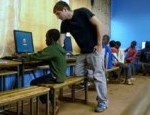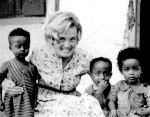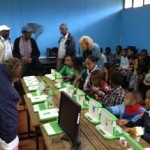Garamendi Legacy Project in Mettu, Ethiopia

When all is said and done, perhaps what will be most important and lasting about the Peace Corps will be what the PCVs did AFTER their tour of service.
One such example is the RPCV Legacy Program of Ethiopia & Eritrea RPCVs (E&E RPCVs) that has been designated by the I.R.S. as a 501 (c)(3) non-profit tax-exempt organization.
The program, organized in 2003 by the group under the leadership of Marian Haley Beil (Ethiopia 1962-64), for the purpose of sponsoring education and healthcare projects that will assist the neediest in-country, and are “championed” – that is designed, administered and fundraised for – by RPCVs and former staff members on a volunteer basis.
To date 8 projects have been launched; five have met their goals and three are continuing. The projects are supported by donations primarily from the group’s RPCVs and to date more than $180,000 has been distributed.
Of the current three projects, one pays for all Hesperian Health Guides sent at the request of those healthcare workers and educators in-country who provide services where there is no high-level medical care available. The second provides summer school enrichment for students living in far southern Ethiopia, and financial support for female students to enable them to continue their schooling.
The third project is being carried out in Mettu, in rural southwest Ethiopia, and is being “championed” by Patricia and John Garamendi who were PCVs there as a young married couple in 1966-68. The “ITC (Instructional Technology Center) for Mettu School” project provides computers, IT support and training for both teachers and students. Today the project is directed in Mettu by one of their students.
Also, involved with this project is a current PCV in Ethiopia, Christopher Cartelli (Ethiopia 2012 -14) who is stationed in Mettu.
Chris, who is from Connecticut and went to UConn, joined the Peace Corps right after college, and while he wanted to serve in Africa, he had absolutely no knowledge of Ethiopia. That soon changed. At UConn he had majored in political science, but given Peace Corps logic, was assigned as an Ag Volunteer to rural Mettu, one of the famous hardship posts for PCVs.
I asked Chris to write and tell me how he got involved in the Garamendi project and how is the computer training going in Mettu.]
Here is what Chris had to say.
My involvement in the Garamendi ITC Lab project at St. Gabriel School in Mettu began when I met Tefere Kebede, a former student of Mrs. Garamendi, who has taken the initiative to oversee the project and ensure its success. Last spring he asked me to come in three days a week and train teachers after school in the computer lab. As an Ag/Environment volunteer this was a secondary project for me. Kebedei would be teaching students in the lab during the day so I could still fulfill my obligation with the agriculture office in town. I was free in the evenings; really I was free all the time, so I jumped on the chance to get some much needed work going.

Chris working
The first time I climbed the hill up to St. Gabriel School and saw the ITC lab I was impressed. The room was spacious and humming with the sound of computer equipment. Network cables were neatly tucked around the border, connecting the 19 independent computers to the main server. Each workstation had a keyboard, mouse, flat panel monitor and a computer fully loaded with software. On a table in the middle of the room were 20 indestructible One World laptops. I was told these are what they use when the power goes out and they are also going to be made available to take home in the evening for the students to practice.
Around 5 pm teachers started coming in for the afterschool class and soon every workstation was filled. After a brief introduction we got under way and began with the basics; identifying the parts of a computer. By the end of the month-long course we worked our way up to making class rosters on Excel and exploring how to create a PowerPoint presentation. Some teachers were still a bit shaky with the mouse, but many had caught on quickly and were ready to incorporate computer technology into their teaching methods. When the class ended it was June and the school broke for summer.

Patricia as a PCV
Summer was a time for planning. I met every week with Tefere and other members of the St. Gabriel Alumni Association which is the school board in control of the project. We discussed some shortcoming that we saw and ways to improve the lab for the coming school year. There was still room in the budget and the lab needed more equipment; a projector for demonstration, an uninterruptable power source so the computers don’t all crash every time the power goes out, and a printer were all high on the list. Also we discussed the need for a teaching assistant. If I were to take over teaching the students in the fall everyone agreed it would be best if I was paired with a local counterpart trained in ITC. In order to help bridge the language gap between the students and their PCV instructor who is still struggling with Afan Oromo, and to have someone trained and capable of carrying on the project after my two years are up.
Summer was also time to plan for a very important visit. In August John and Patricia Garamendi were returning to Ethiopia and coming to Mettu to see the ITC project they started, and reacquaint themselves with their former home. This is what made the computer lab project so interesting to me. Getting to work on a project started by returned Peace Corps Volunteers who served in my community 47 years ago, essentially connecting my service to theirs and continuing the Peace Corps legacy in Mettu, it was something few Volunteers get to experience.
The Garamendi’s came and their visit went smoothly. There were coffee ceremonies and buffets of traditional food to make them feel welcome in their former site. The town administrators swept them up and wanted to give them a tour of all that was on the rise in the community, including a brand new university. But the most important thing for the Garamendi’s, and for those of us working on the project, was to get them to the school so they could finally see the fruits of their labor in person.

Patricia visits with the computer students
When they entered the lab for the first time I could see by the looks on their faces they had the same feeling as I did the first time I saw it. Just hearing about it or seeing it in pITCures you can’t really grasp how amazing this computer lab is. You walk up the rough and rocky dirt road to the gate of the slightly dilapidated school compound, past grazing cattle between classrooms and administrative buildings. A man bangs on an old truck brake drum hanging from a tree with a stick to signal the time to change classes. When you open the heavy metal door to the ITC lab filled with sleek high-tech equipment and the sound of clicking keyboards it feels like your entering another world.
One reason the Garamendi’s have to be so proud of this project is their former students who are so deeply involved in running it. Anyone can write a check and fund an ITC lab somewhere in Africa, but only an RPCV can have the long lasting community connections so that the project is run by community members who they once taught in the very same school. Without the lessons learned as the students of Peace Corps Volunteers the idea of volunteerism would not be such a part of their ways of thinking, and this ITC lab would not be nearly as successful without their input as volunteers on the project.
After the Garamendi’s left things started moving very quickly. Everyone was inspired to make the computer classes even better than last year. New equipment from Addis was delivered, a teaching assistant was found and trained, and classes began in the lab at the start of the new school year.
Currently the lab is being used every day of the week. In the morning we have a group of 20 4th grade students, and in the afternoon there are another 20 6th and 7th graders who are learning computer skills. Each group comes three days a week and the students are picking it up incredibly fast. Most of them had never used a computer before, but after the first week they were drawing Ethiopian flags in Microsoft Paint, exploring the encyclopedia, typing their names with WordArt, and making their own PowerPoint’s describing the members of their families. The computers also have Internet access so they are able to Google their favorite school subjects, although it’s a constant challenge trying to block them from downloading Ethiopian TV dramas which eat up the bandwidth.
The current goal is to rotate enough groups through the computer classes that all the students coming out of St. Gabriel School are computer literate, and to train as many teachers as are willing to participate so the teaching methodology at this rural primary school is as advanced as any in Ethiopia. I will be working on this project for the remainder of my service, and I hope as any Peace Corps Volunteer would that by the time I leave my presence will no longer be necessary.
I and my significant other (Ethiopian) enjoyed and were uplifted by this inspiring article. Heartfelt thanks for all your good work. Please keep doing good for as man people as you can.
Nice to get such an excellent update of this project.
Charlie Ipcar
Ethiopia 1965-68
I am so happy this article is still posted.
John and I visited the school Aug 2021.
Every time we go we are amazed to see the
Love and care that keeps it going.
Our students from 1966-68 continue to manage it with great care. The Board still exists and the annual money that we send through the E&E RPCVs legacy project has continued to be managed by RPCV Randy Marcus
Thank you Randy for the careful transfer of funds to the bank in Mettu. Thank you also to RPCVs that have joined us in contributing to the fund.
My Student Teferi Kebede Voluntarily Directs the program. He considers himself a Peace Volunteer to his own country Ethiopia.
Our youngest daughter Faith is my partner in this project. She is an art teacher and will always carry the project forward. She has visited the village with me several times but now is married with two little boys . She will guide her own siblings to the village one day. Mettu is a place of incredible memories and the people still call out
Astigmari as we walk by.
“And the beat goes on”—-wonderful work and wonderful story Patricia—-great to see the next generations serving the people of Ethiopia, lo these many years since you and John made it your home. The Peace Corps spirit never dies!!!